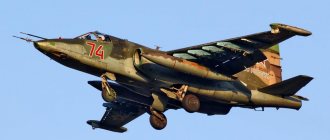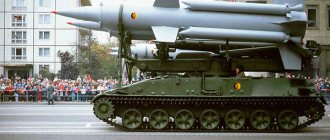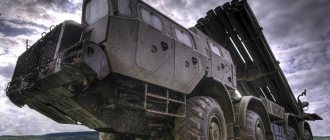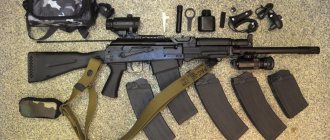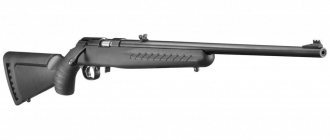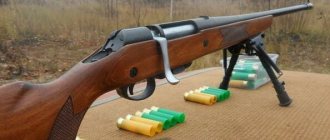The S-125 anti-aircraft missile system (Sa-3 “Goa” - according to the US/NATO classification) is designed to destroy air targets at low and medium altitudes. The complex is all-weather, capable of hitting targets on a collision course and in pursuit, and in exceptional cases, firing at radar-observed ground and surface targets. Development of the complex began in 1956 at KB-1 (now Almaz). General designer A. Raspletin. The anti-aircraft guided missile was developed by the Fakel design bureau, general designer P. Grushin.
S-125 Neva air defense system - video
Testing of the complex began in 1961, at which time it was adopted by the air defense forces of the Soviet Army. At the same time, shipborne versions of the Ml “Volna” (SA-N-1A) and Ml “Volna M” (SA-N-3) complexes were developed for the Navy. The 5V24 two-stage solid-fuel rocket is made according to a normal aerodynamic design. Its flight is controlled using commands generated by the missile guidance station and transmitted via a radio control line on board. The rocket has a solid-fuel starting engine, the operating time of which before being dropped is 2.6 s. The main engine is also solid fuel; it starts after the starting engine has finished working and runs for 18.7 s. After the launch accelerator is released, the rocket begins to receive control commands to aim at the meeting point with the target. The first stage (starting engine) is a PRD-36 powder jet engine (14 powder bombs with a total mass of 280 kg). The second stage engine is a powder bomb weighing 125 kg. The 4G90 warhead is high-explosive fragmentation, with ready-made submunitions weighing 60 kg (32 kg for explosives and 22 kg for submunitions). The missile uses a Doppler radio fuse. The radius of dispersion of fragments on targets of the F-4 type is 12.5 m. The missile has a radio fuse, the first stage of which is removed after the missile moves 300 m from the launcher. If the missile does not hit the target, it will self-destruct.
In 1964, a new 5B27 missile was put into service. It differed from the previous design of the main engine and had a new, more powerful 5B18 warhead weighing 72 kg. Due to this, the speed of the missile and the size of the affected area increased. To detect and track air targets, as well as to transmit control commands to the missile defense system, the SNR-125 missile guidance station is used, which operates in the 1st wave band (8.9-9.46 GHz). It has specially configured antennas positioned to reduce the effects of ground reflections. The maximum target detection range is 110 km. The antenna radiation pattern width is 12°x1.5°. The antennas have a mechanical beam scanning device, which allows simultaneous viewing of a certain area of space. The SNR allows one or two missiles to be aimed at a target at the same time. To ensure the ability to work in conditions of interference, the station is equipped with a television optical camera that allows you to detect targets at ranges of up to 25 km, as well as monitor the results of firing. The complex uses 5P71 or 5P73 launchers. One 5P71 launcher carries 2 missiles, and one 5P73 launcher carries 4 missiles. Charging time - 1 min. To transport and load missiles, a transport-loading vehicle based on a ZIL-131 or ZIL-157 (early versions) cross-country truck is used. The characteristics of the missile and warhead allow it to fire at both ground and surface radar-observable targets.
For early detection of targets, the S-125 Neva division includes a P-15 C-band two-dimensional all-round radar station (810-950 MHz). It has two parabolic antennas located one above the other and a radiation pattern width in the vertical plane of 5e, and in the horizontal plane - 2°. Many divisions are equipped with the P-15M radar, which is distinguished by the fact that the antenna can be installed on a tower with a height of 20 to 30 m. This increases the detection range of low-altitude targets. To determine the height of tracked targets, the PRV-11 radar altimeter operating in the E-band (2.5-2.7 GHz) is used. The maximum detection range is 180 km, the maximum detection altitude is 32 km.
The first combat use of the complex was registered in 1970. In Egypt, 18 divisions were deployed to cover the Suez Canal zone and other important administrative centers. Before the UN truce concluded in the same year, 5 F-4A Phantom aircraft were shot down with the help of the C-125.
The main combat test of the complex took place in 1973, when Syria and Egypt used a large number of complexes against Israeli aircraft. By the beginning of the war, the Egyptians had 146 anti-aircraft missile divisions, about a third of which were S-125s. During this war, Arab air defense used up 2,100 S-75, S-125, and Kvadrat missiles. They shot down 46 Israeli aircraft, 6 of them with the C-125 complex. During the war, some complexes were captured intact by the Israelis and handed over to American experts for detailed study.
Since 1973, the C-125 has been used by the Armed Forces of Iraq (during the Gulf War of 1980-1988), Syria (for air defense of the Bekaa Valley), Libya (to repel air raids by the US Navy and Air Force in 1986), Angola (to combat South African aviation). The complex was also used by the Iraqi Armed Forces during the 1990-1991 Gulf War.
8 C-125 divisions were used to defend Belgrade when repelling NATO air raids against Yugoslavia. According to some sources, it was with the help of a C-125 equipped with a thermal imager that the F-1I7 stealth aircraft was shot down. The S-125 air defense system was exported to many countries around the world: Afghanistan, Angola (3-ZRK), Algeria (5), Bulgaria. Hungary (6), Vietnam (40), Egypt (55), Yemen (3), India (12), Iraq, Korea (8), Cuba (12), Libya, Mali (3), Mozambique (3), Peru (2), Poland, Syria (40), Tanzania (5), Czech Republic, Finland (3), Ethiopia (8), Yugoslavia (8). The complex was exported under the name "Pechora". In Russia it has already been withdrawn from service, but in many countries it continues to be in service.
Antenna post of the SNR-125 missile guidance station
Anti-aircraft missile system S-125M Neva-M
The system includes an anti-aircraft missile system (SAM), 5V24 or 5V27 anti-aircraft guided missiles (SAM) and technical support equipment.
The air defense system includes the following fixed assets.
- tracking and guidance radar station SNR125M, located on two trailers (UNK control cabin and UNV antenna post); SNR 125M has radar and television tracking channels operating in automatic and manual modes. The station is equipped with an automated missile launch device APP-125 designed to determine the boundaries of the air defense missile system's engagement zone, solve the launch problem and determine the coordinates of the meeting point between the target and the missile.
- a missile battery including 4 5P73 launchers with four missiles each;
- power supply system, including a distribution cabin UNS and a diesel-electric station. It is possible to connect to industrial networks.
The complex is single-channel for the target and two-channel for the missile. Two missiles can be aimed at a target simultaneously.
Additionally, the air defense system can be equipped with radar detection and target designation radars P-12 and P-15. Air defense systems are located in transported trailers and semi-trailers, communication between them is carried out via cable.
Solving the complex task of creating a low-altitude air defense system required non-trivial technical solutions. This, in particular, is responsible for the unusual appearance of the UNV SNR-125 antenna device (see.
). To hit a target flying at an altitude of 200 m at a speed of 420 m/s at the 10 km mark, it is necessary to launch the missile when the target is at a distance of 17 km, and to lock onto the target for auto tracking (AS) at a distance of 24 km. Then the detection range of such a low-altitude target should reach (taking into account the time for additional search) 32-35 km. In this case, the elevation angle of the target when detected is only about 0.3°, and when taken on the AC - 0.5°. At such small elevation angles, the magnitude of the radar signal from the missile guidance station reflected from the ground exceeds the magnitude of the signal reflected from the target. To reduce this influence, the C-125 includes two antenna systems. One is non-scanning, receiving and transmitting, the other is scanning, receiving. When operating at low altitudes, the transmitting antenna is set to 1°. In this case, the transmitter irradiates the ground only with the side lobes of the antenna's radiation pattern, which reduces the signal reflected from the ground tenfold. To reduce the target tracking error associated with the so-called “mirror reflection”, which is the interference of direct and reflected target signals from the ground, the receiving antennas of both viewing planes are rotated 45° relative to the horizon. This predetermined the characteristic appearance of the antenna post of the Pechora air defense system.
Another difficult task associated with the low flight altitude of the target was the creation of moving target selector (MTS) equipment that effectively distinguishes the target signal against the background of powerful reflections from the ground and passive interference. Here, for the first time, a periodic subtracting device was developed using solid ultrasonic delay lines (ULLs). The characteristics of this SDC significantly exceeded the characteristics of all existing pulsed radiation radars. Suppression of passive interference and reflections from stationary objects reached 33:36 dB. To stabilize the repetition period of the probing pulses, the SNR synchronizer was adjusted to the ULZ delay line. In the future, this became a disadvantage of the station, since it did not make it possible to arbitrarily change the repetition frequency to tune out synchronous impulse noise. To combat active interference, a system was provided to jump the transmitter frequency when the interference exceeded a given level.
The 5V27 (V-601, 4K91) two-stage missile defense system is made according to the canard aerodynamic design (see.
). The first stage is a solid-fuel accelerator with four stabilizers installed on it, which can be deployed after launch, and two aerodynamic surfaces on the transition connecting compartment, ensuring a reduction in the flight range of the accelerator after its separation. After the stages separated, these surfaces unfolded, which led to intense rotation and braking of the accelerator with the separation of all or several stabilizer consoles and its disorderly fall. The second stage of the rocket is also equipped with a solid propellant propulsion system. Structurally, the second stage consists of a number of compartments in which a radio fuse, rocket rudder control units, a high-explosive fragmentation warhead, on-board equipment units, a solid propellant rocket engine, and control command receivers are located.
The missile's flight is controlled and aimed at the target by radio commands received from a ground-based guidance radar station, and the warhead is detonated by a command from a radio fuse when approaching the target at the required distance or from the guidance station. The operating time of the starting accelerator was 2...4 s, the main engine - up to 20 s. To increase the range of the missile, the missile was also aimed at the passive part of the trajectory; the self-destruction time was 49 s. The missile maneuvers with an overload of up to 6 units. The operating temperature range is from -40° to +50°.
Simultaneously with the adoption of the V-601P missile, work began to expand the combat capabilities of the air defense system, incl. to ensure shelling of targets at speeds of up to 2500 km/h, firing at transonic targets at altitudes of up to 18 km, increasing the probability of hitting targets and increasing noise immunity.
The following modifications of the rocket were created:
- 5V27G - sealed;
- 5V27GP - sealed, with the closest border of the affected area reduced to 2.7 km;
- 5V27GPS - sealed, with an approximate near boundary of the affected area, with a selecting block that reduced the likelihood of the radio fuse being triggered by reflections from local objects when firing at low-flying targets;
- 5V27GPU - a 5V27GP rocket with accelerated pre-launch preparation, which was achieved by supplying increased voltage to the on-board equipment from a ground-based power source in the mode of pre-launch warming up of the equipment (the pre-launch preparation equipment in the UNK cabin was also modified accordingly).
B-601 missiles of all modifications were produced by Kirov plant No. 32. For training and training of personnel, dimensional and weight mock-ups of missiles, operational training and cut-out mock-ups of missiles were produced.
The rocket launch is inclined, from the 5P73 launcher (see.
), guided by elevation and azimuth. The transportable four-boom launcher 5P73 (SM-106) was designed at KBSM under the leadership of chief designer B.S. Korobov. The launcher without gas deflectors and chassis was transported by a YaAZ-214 vehicle. When firing at low-altitude targets, the minimum missile launch angle was 9°. To prevent soil erosion during missile launches, a special rubber-metal multi-sectional circular coating was laid around the launcher. Loading of the launcher was carried out sequentially by two transport-loading vehicles based on the ZIL-131 or ZIL-157 all-terrain vehicle.
To provide power supply from the industrial network, a mobile transformer substation mounted in the back of a two-axle car trailer was used. The P-12NM (P-18) and P-15 reconnaissance and target designation stations assigned to the S-125 divisions were equipped with their own autonomous power supplies AD-10-T/230MAB-8-0/230M and AB-4-T/230M.
The nationality of the aircraft was determined by ground-based radar interrogators (NRZ) “Password-3P” (75E6) or “Password-4P” (1L22) assigned to the division.
In the early seventies, the S-125M complex was modernized in terms of improving electronic equipment, which ensured increased noise immunity of the target sighting and missile control channels. With the introduction of television-optical sighting and target tracking equipment “Karat-2” (9SHZZA), the ability to visually track and fire at a target without radar radiation into space was achieved. In this case, the transmitter of the target channel switched to an equivalent antenna located at the antenna post. The work of jamming aircraft with visual visibility was greatly facilitated. However, the optical target sighting channel lost effectiveness in bad weather and cloudy conditions, as well as when observing towards the sun or at a pulsed light source placed by an attacking aircraft. In addition, television optical sighting did not provide information about the range to the target, which limited the choice of guidance methods and significantly reduced the effectiveness of shooting at high-speed targets.
In the second half of the seventies, equipment was introduced into the air defense system that increased the effectiveness of use against targets at extremely low altitudes and when firing at ground and surface targets. In addition, a new modification of the 5V27D missile defense system was created with an increased flight speed, which made it possible to introduce “catch-up” fire on targets. The length of the missile defense system increased, the weight increased to 980 kg with the mass of the launch accelerator being 407 kg. But for the heavier 5V27D, loading the 5P73 launcher with only 3 missiles was allowed. The S-125M1 complex with the 5V27D missile was put into service on May 3, 1978.
Modifications of the S-125 air defense system
For USSR air defense
S-125 “Neva” - (1961) basic complex, equipped with V-600P (5V24) missiles with a range of up to 16 km.
S-125M "Neva-M" - (1970) development of a complex with V-601P (5V27) missiles with a range of up to 22 km.
S-125M1 “Neva-M1” - (1978) a modernized version of the S-125M with improved noise immunity and equipped with V-601PD (5V27D) missiles with the ability to fire in pursuit.
For the USSR Navy
M-1 "Volna" - (1962) an analogue of the ship-based S-125 "Neva" complex.
M-1M "Volna-M" - (1964) an analogue of the S-125M "Neva-M" complex equipped with V-601P (5V27) missiles.
M-1P "Volna-P" - (1974-1976) modernized version with improved noise immunity, control systems and the addition of the 9Sh33 television system.
M-1N "Volna-N" - (after 1976) further modernization of the complex to combat low-flying anti-ship missiles, equipped with B-601M missiles.
Export
S-125 "Pechora" is an export version of the S-125 "Neva" complex.
S-125M "Pechora-M" - an export version of the S-125M "Neva-M" complex.
S-125 Pechora-2M - self-propelled version (supplied to a number of countries).
SAM S-125-2T "Pechora-2T"
Air defense systems: From guns to missiles. S-125 - “gazelle” with sharp horns
PU ZRKS-125 / Photo: IA “ARMS OF RUSSIA”, Anatoly Sokolov
One of the foreign names of the Soviet S-125 Goa air defense system translated from English means gazelle.
As the experience of local wars has shown, this “gazelle” has sharp “horns” and shot down about 70 aircraft in the Middle East and Yugoslavia.
The complex is distinguished by high operational reliability and today is in service with at least 20 foreign armies. Medium-range anti-aircraft missile systems (SAM) such as S-75 (USSR), Nike-Ajax and Nike-Hercules (both USA) changed tactics and methods of using air attack weapons (AAM). To increase the likelihood of completing combat missions, airborne forces began to use extremely low (up to 200 m) and low (from 200 to 1000 m) flight altitudes. This led to a sharp decrease in the range of their timely detection and, as a result, the probability of defeat.
SAM MIM-23-Hawk / Photo: www.eneger.com
History of creation
The problem of combating low-flying targets was solved by creating low-altitude anti-aircraft systems. The first of these was the American Hawk air defense system with a minimum height of destruction of air targets of about 30 m. Around the same time, the USSR created an all-weather, low-altitude single-channel transportable air defense system S-125 (SA-3, Goa - according to the US and NATO classification) in consisting of a missile guidance radar station (SNR-125), an anti-aircraft guided missile (SAM), a launcher (PU) and technical support equipment. The new air defense system was created by resolution of the Council of Ministers (No. 366-255 of March 19, 1956) in 1960 by KB-1 (now NPO Almaz) in cooperation with other enterprises.
Photo: yandex.ru
The decisive role in the creation and adoption of the C-125 was played by the B-600 missile, which was created by NII-10 (now MNIRE "Altair") for the shipborne air defense system M-1 "Volna". On the basis of the “sea” missile, the V-600P missile was created for a ground-based anti-aircraft complex. The first Soviet solid-fuel anti-aircraft guided missile (SAM) was made according to the canard aerodynamic configuration and had high maneuverability when flying at low altitudes. The unified B-600 (B-601) missiles were mass-produced by Plant 32 in Kirov (now the Vyatka Machine-Building Enterprise "Avitek"), which subsequently produced missiles for the Osa, Tor and Klinok air defense systems.
The first anti-aircraft missile regiments with the S-125 complex were deployed in 1961 in the Moscow Air Defense District and subsequently, together with the S-75 and S-200 air defense systems, became part of mixed air defense brigades. During practical operation, the S-125 air defense system was repeatedly modernized and currently the following variants of its design are best known.
S-125 air defense missile / Photo: RUSSIA WEAPONS news agency, Anatoly Sokolov
Options and main characteristics
SAM S-125
designed to combat aircraft and cruise missiles at low and medium altitudes in complex jamming environments day and night. The complex is capable of operating autonomously and as part of an air defense system together with other anti-aircraft weapons.
The first version of the S-125 ensured the destruction of high-speed (410-560 m/s) targets at altitudes and ranges of 0.2-10 km and 6-10 km, respectively. The complex hit supersonic targets with overloads up to 4 g at altitudes of 5-7 km, and subsonic targets with overloads up to 9 g - from altitudes of 1000 m. Targets operating under the cover of passive jamming were “reached” by the air defense system at altitudes up to 7 km, and the director active interference - 300-6000 m. The probability of hitting a target with one missile in a simple environment and in passive interference was 0.8-0.9 and 0.49-0.88, respectively.
Launch of the S-125 air defense missile system / Photo: kollektsiya.ru
The SNR-125 station of the centimeter (3-3.75 cm) wave range provided detection (up to 110 km), identification, tracking and guidance of up to two missiles at one target, as well as monitoring of firing results. To detect low-flying targets, it had a radar channel (specially configured antennas to reduce reflections from the ground) and a television-optical sight to track targets in interference from a range of 25 km.
Antenna system of the S-125 air defense system / Photo: NPO Almaz
A two-beam launcher with a tracking electric drive served to accommodate two missiles, their preliminary guidance and inclined launch at the target. Loading the launcher in no more than 2 minutes and transporting the missiles was provided by a transport-loading machine.
Loading PU S-125 with TZM / Photo: yandex.ru
The V-600P solid-fuel two-stage missile defense system was equipped with a high-explosive fragmentation warhead with a radio fuse with a total mass of 60 kg. When it was detonated, up to 3570 fragments were created weighing about 5.5 g with a dispersion radius of 12.5 m. In case of a miss, the rocket self-destructed 26 s after launch. To increase the target detection range, the complex was equipped with surveillance radar stations (radars) of the P-12 “Desert” and P-15 “Trail” types in the meter and decimeter ranges, respectively.
All SAM equipment was located in towed car trailers and semi-trailers. It took from 4 to 6 hours to deploy the main elements of the complex at a prepared position.
Control cabin SNR-125 / Photo: s00.yaplakal
SAM S-125 "Neva-M"
is a further development of the complex, which was put into service in 1970. The complex used the new V-601P missile, a modified SNR-125 with improved characteristics and a new launcher for four missiles of the V-600P and V-601P types, as well as a modernized transport charging machine.
The new missile weighing 980 kg (warhead - 72 kg) ensured the destruction of targets at a flight speed of up to 560 m/s (up to 2000 km/h) with a probability of 0.3-0.7 at a range of up to 17 km in the altitude range of 200-14000 m Low-altitude (100-200 m) and transonic aircraft were destroyed at a range and altitude of up to 10 km and 22 km, respectively.
Photo: stroi-web.ru
When a missile warhead exploded, up to 4,500 fragments weighing 4.72-4.79 g were formed. To expand the affected area, the missile's self-destruction time was increased to 49 s and its control was used on the passive part of the flight path. The reloading time of the launcher missiles did not exceed 1 minute.
The S-125M1
"Neva-M1"
is the result of the modernization of the S-125M air defense system in the 1970s, which was put into service with the 5V27D missile in 1978. It was distinguished by increased noise immunity of channels and the ability to fire at a target when it was visually visible using television-optical "Karat-2" equipment. The new equipment made it possible to fire at low-flying targets at extremely low (less than 200 m) altitudes and ground (surface) radio-contrast targets.
The improved 5V27D missile defense system made it possible to fire at targets “in pursuit”. With increased weight and size characteristics, no more than three missiles were placed on the launcher. At the beginning of the 1980s. SNR-125 of all modifications were equipped with “Dubler” equipment with remote radar simulators for protection against anti-radar missiles.
5V27D type missile for the S-125 air defense system / Photo: RUZHIEROSSIYA news agency, Anatoly Sokolov
The main options for modernizing the S-125 air defense system
Since its creation, the complex has enjoyed well-deserved “authority” and great demand abroad. Over the past years, about 530 S-125 air defense systems under the name “Pechora” have been delivered to 35 foreign countries, and today this complex is in service with about 20 foreign armies. In terms of its operational reliability, Pechora has become one of the best examples of air defense systems.
Over several decades of operation, a significant number of complexes have not exhausted their resources and are capable of solving tasks as intended, just like years ago. However, to meet modern requirements, it is necessary to modernize about 500 S-125 air defense systems, which are in service with foreign armies. The use of modern technologies can significantly increase the combat capabilities of the complex at relatively low costs compared to the acquisition of new air defense systems with comparable characteristics.
S-125T air defense system / Photo: IA “ARMS OF RUSSIA”, Anatoly Sokolov
SAM S-125-2A "Pechora-2A"
- an option for modernizing this complex, which was developed by NPO Almaz. According to the developers, in conditions of intense electronic countermeasures (up to 2000 W/MHz), the 5V27D missile defense system with a probability of 0.4-0.9 will hit high-speed (up to 700 m/s) aerodynamic targets in the range of ranges and altitudes of 3.5-28 km and 0.02-20 km, respectively. The time for transferring the air defense system to the combat (traveling) position does not exceed 100 (80) minutes.
The S-125-2A complex implements the principle of automatic acquisition and tracking of a target by a television channel, automated combat work, and uses a modern element base. At the same time, its operational characteristics have been improved, the volume of routine maintenance has been reduced, the time required to carry it out, and the energy consumed have been reduced, as well as the service life has been extended. When these and other measures are implemented, the life cycle of the complex is extended by 10-15 years, and all necessary work can be carried out on the customer’s premises.
S-125-2A air defense missile launcher "Pechora-2A" / Photo: www.rusarmy.jpg
SAM S-125-2M (K) "Pechora-2M" ("Pechora-2K")
in mobile (container) versions created by the Interstate Financial and Industrial Group (IFIG). The complex of one 5V27DE missile defense system is capable of hitting targets with a maximum flight speed of 700 m/s at ranges of 3.5-32 km and altitudes of 0.02-20 km with a probability of 0.4-0.9. An improved SNR with radar, television and thermal imaging channels ensures target detection at ranges of up to 80, 60 and 30 km, respectively.
S-125-2M SAM launcher / Photo: IA “ARMS OF RUSSIA”, Anatoly Sokolov
The modernized "Pechora" has a high degree of automation of combat work and technical condition monitoring, reliable exchange of information with other means, a reduced volume of routine maintenance and an 8-10 times reduced range of spare parts. The increased survivability of the air defense system in conditions of active opposition from the enemy is ensured by the KRTZ-125-2M electronic defense complex, which “deflects” anti-radar missiles to a distance of up to 300 m from the SNR-125.
KRTZ-125-2M / Photo: IA “ARMS OF RUSSIA”, Anatoly Sokolov
The modernized complex differs from other analogues in its increased range and effectiveness in hitting targets, reliability and service life, as well as reduced operating costs and the composition of the combat crew. In addition, the S-125-2M (K) air defense system has high mobility and a reduced duration of up to 30 minutes. time to bring into combat position due to the placement of the main elements of the complex on a vehicle chassis. Along with this, the modernized Pechora-2M has high potential for further enhancing its combat capabilities.
Optical-television device of the S-125-M(K) air defense system / Photo: IA “ARMS OF RUSSIA”, Anatoly Sokolov
Other countries are also offering their options for modernizing the S-125 complex.
SAM S-125-2T "Pechora-2T"
capable of effectively combating modern airborne weapons, incl. and unobtrusive, in difficult interference conditions day and night. It was created by the Belarusian enterprise “Tetrahedron” and is of great interest in other countries. By transferring up to 50% of the complex’s equipment to a new element base, its fire capabilities and operational reliability were significantly increased, maintenance time and the range of spare parts were reduced while simultaneously increasing the service life. Modernization of the S-125 air defense system can be carried out in basic and expanded versions.
With one 5B27 missile, the S-125-2T Pechora-2T air defense system is capable of hitting targets operating at a maximum speed of up to 900 m/s at ranges and altitudes of 3.5-26.5 km and 0.02-25 km, respectively, with a probability 0.3-0.96 depending on their type. The complex can simultaneously fire two targets with two missiles each. The approximate time for reloading the launcher and transferring the air defense system to the combat position is 1 and 4-5 minutes. respectively.
S-125 “Neva-SCE” (“Newa-SCE”)
is a Polish version of the modernization of the complex. It involves improving its main elements, except for the antenna system and missile defense systems, using a modern element base. The complex includes a modernized SNR on a vehicle chassis, three launchers with 4 guides each on a tank or vehicle chassis, communications, control and support equipment.
With increased noise immunity, the modernized air defense system can receive information about the air situation within a radius of up to 300 km and detect targets in interference using standard reconnaissance equipment at an increased range. In addition, its maintenance staff has been reduced by 65% and the number of vehicles has been halved. However, this option for modernizing the S-125 air defense system does not provide for increasing the service life of the 5V24 missile defense system.
MU SAM S-125 “Neva-SCE” / Photo: gallery.military.ir
According to the developers, the S-125 “Newa-SCE” air defense system with the 5B24 missile defense system is capable of hitting targets with one missile at ranges and altitudes of 2.5-25 km and 0.02-18 km, respectively, with a probability of 0.4-0.7. The maximum speed of targets is 700 m/s, the reloading time of the launcher is 1 minute, the time for transferring the air defense system to the combat position is up to 3 minutes.
In connection with the creation of the Polish version of the modernization of the Neva-SCE air defense system without the participation of Russian developers, they declared that they were not responsible for possible negative consequences if it were implemented.
Combat use
The “baptism of fire” of the S-125 air defense system took place in 1970 on the Sinai Peninsula. Using ambush tactics, the first was shot down on June 30, the second was shot down five days later, and four and three Israeli planes were shot down on July 18 and August 3, respectively. In addition, three Israeli Air Force aircraft were damaged. During the Yom Kippur War with Israel (October 1973), Egyptian and Syrian S-125 air defense systems shot down 21 (61 shots, consumption of 174 missiles) and 33 (72 shots, consumption of 131 missiles) Israeli aircraft.
Photo: weaponscollection.jpg
S-125 systems were used by Iraq in the Iran-Iraq War (1980-1988), and in 1991 when repelling air strikes from multinational forces. This air defense system was used by Syria against the Israelis in the Lebanese crisis (1982) and by Libya to shoot at US aircraft in the Gulf of Sidra (1986).
Wreckage of the F-117A aircraft / Photo: iboards.paralay.jpg
It was the S-125 air defense missile system that, using two 5B27 missiles, while repelling attacks by NATO aircraft on Yugoslavia on March 27, 1999, was the first in the world to shoot down an American stealth aircraft F-117A. This happened 32 km from Belgrade and 13 km from the launch site. The target was tracked in the infrared (IR) range using a thermal imager.
MOSCOW, WEAPONS OF RUSSIA, Anatoly Sokolov www.arms-expo.ru 12
Modern modifications
S-125 Pechora-2T - Belarusian modification of the S-125 developed by NPO Tetrahedr;
S-125-2TM "PECHORA-2TM - Belarusian modification of the S-125 developed by NPO Tetrahedr, 2006. The noise immunity of the complex ensures the operation of the air defense system when it is jammed with a power of 2700 W/MHz (at the output of the jammer's antenna) at a distance of 100 km from the air defense system, the minimum detectable ESR of the target is 0.02 m², the destruction range is 35 km.
S-125 Pechora-2A is a Russian modification of the S-125 developed by OJSC GSKB Almaz-Antey. The target engagement range is 28 km. The target detection range with an EPR of 2 m² is 100 km. Engine operating time is 24 seconds[5]. SAM noise immunity: increased from 100 to 2000 W/MHz (active interference power at the output of the jammer antenna), the detection range in interference is reduced by 2 times. Minimum target ESR 0.3 m²
S-125 Pechora-2M is a Russian modification of the air defense system developed by Defense Systems OJSC. The minimum RCS of the target is up to 0.1 m²[8], a radio-technical protection complex (KRTZ) against anti-radar missiles (ARM) has been introduced. In 2007, the system was tested at the test site; during the shelling of the complex, not a single one of the missile launchers hit the target. Protection against active and passive interference is provided through the introduction of new equipment. The mass of the warhead has been increased by 50%, and the spread of fragments has been increased by 3.5 times. Main characteristics of the complex:
The surveillance radar was replaced with a modern “Casta-2E2”
— number of launchers: 8 units; — maintaining up to 16 air objects; — distance of the control center from the control center: up to 10 km;
The complex has the ability to interface with remote radars and higher command posts via telecode channels. It is possible to effectively fire at cruise missiles and use either one illumination and target guidance radar or two (at two different targets). The optical station provides operation not only during the day, but also at night.
Anti-aircraft missile system S-125M1 "Neva-M1"
Tactical and technical characteristics of the S-125 Pechora-2M air defense system
— Developer: KB-1 (head), OKB-2 (missile) and others — Chief designer: A. A. Raspletin, Yu. N. Figurovsky, P. D. Grushin — Years of development: 1956 — 1961 — Adoption : June 21, 1961 - Manufacturer: Rocket: Plant No. 32 (Kirov)
Destruction range of the S-125 air defense system
— Maximum range, km: 32 — Minimum range, km: 3.5
— Probability of defeat: 0.51(30km)-0.98(20km) — Flight time to maximum range: up to 4 minutes
— Maximum speed of targets hit (m/s): 1000 — Min. epr. (m2): 0.1
— Maximum target height, km: 20 — Minimum target height, km: 0.02
ZSU, SAM, ZRPK
S-125 “Neva”, “Pechora”. SAM. (THE USSR)
S-125 "Neva" is a Soviet short-range anti-aircraft missile system. The complex is designed to hit targets at low and medium altitudes. The air defense system is capable of operating in any weather conditions. Hitting a target is possible both on a collision course and in pursuit. In some cases, the S-125 can be used to fire at ground targets in the observation zone.
Weapons began to be created in 1956 at the Almaz design bureau, under the leadership of A. Raspletin. The rocket itself was created at the Fakel design bureau, the development was led by P. Grushin. The first tests were carried out in 1961, after which the anti-aircraft missile system was adopted by the air defense forces of the army of the Soviet Union. In addition, analogues of the complex were created for placement on ships.
S-125 “Neva”, “Pechora”. SAM. (THE USSR)
The 5B24 rocket is a two-stage, solid-fuel rocket, the design uses a normal aerodynamic shape. The missile's flight is controlled from the guidance station using commands transmitted via radio link directly to the aircraft.
The rocket is equipped with a solid propellant engine, which is reset after 2.6 seconds. After the starting engine is reset, the main engine comes into operation, the operating time of which is less than nineteen seconds. The rocket begins to receive commands after the launch engine has already been disconnected. The missile warhead weighs 60 kg, 22 of which are explosives and 32 are submunitions. The missile's destruction radius is slightly less than thirteen meters. If the target avoids being hit, the missile is destroyed.
S-125 “Neva”, “Pechora”. SAM. (THE USSR)
Since 1964, the complex was equipped with 5B27 missiles, which were somewhat different from the previous one, and also had a larger target engagement area.
Targets are detected and further tracked by a guidance station. The station has antennas of a special design, which makes it possible to somewhat reduce the influence of reflection from the ground. The maximum distance at which targets can be detected is 110 kilometers. The missile guidance station allows you to control two missiles simultaneously. In case of large interference, in order to detect the target and further monitor the shooting results, there is a special television camera with which you can detect targets at a distance of up to 25 kilometers.
The complex recharges within one minute. Transport-charging machines are used for loading.
S-125 “Neva”, “Pechora”. SAM. (THE USSR)
For the first time, in combat conditions, the C-125 was used in 1970 in Egypt, where it was used to cover the Suez Canal, as well as some important centers. A total of eighteen divisions were deployed. During their service, before the armistice, they shot down five Phantom aircraft. They were most widely used against Israeli air forces, when 146 divisions were deployed on Egyptian territory. About a third of these were C-125s. During the fighting, 46 aircraft were shot down, with six C-125s shot down.
The S-125 in its export version was called “Pechora” and was supplied to many countries around the world, where it was used in many conflicts.
S-125 “Neva”, “Pechora”. SAM. (THE USSR)
Characteristics of various variants of the S-125 air defense system:
| S-125M "Neva-M" with V-600P (5V24) missile | "Pechora" with the V-601P (5V27) missile | "Pechora" with the V-601PK missile | "Pechora-2A" with the V-601D missile | "Pechora-2M" with 5V27DE missiles | |
| Max. speed of targets hit (m/s). | 560 | 560 | 560 | 700 | 1000 |
| Min. epr. (m2) | 0,5 | 0,3 | 0,3 | 0,3 | 0,1 |
| Max. target height, km | 10 | 18 | 16 | 20 | 20 |
| Min. target height, km | 0,2 | 0,02 | 0,02 | 0,02 | 0,02 |
| Max. range, km | 12 | 17,5 | 14 | 28 | 32 |
| Min. range, km | 6 | 3,5 | 3 | 3,5 | 3,5 |
| Probability of defeat | 0,25 — 0,97 | 0,39 — 0,98 | 0,4 — 0,99 | 0,41 — 0,99 | 0.51(30km)-0.98(20km) |
